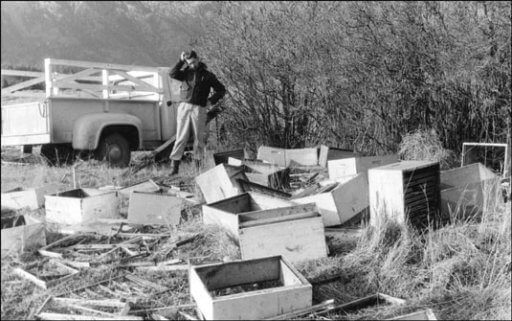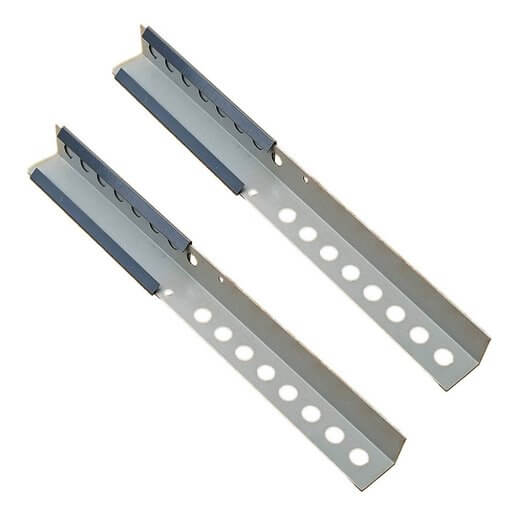You invest a ton of time and energy into building, maintaining, and harvesting honey from your beehives – so the last thing you need is for an animal to get into them and ruin all your hard work.
From mice to bears to wasps, marauding animals can wreak havoc on, and even destroy, your beehives. Some of these animal vandals eat the bees themselves while others are after the honey. We’ll discuss both coming up.
Here, we’ve broken down some key strategies, animal by animal, to keep each type out of your hives.
Protect Beehives from Bears
Despite being a fictional account of anthropomorphized animals in the forest, the Winnie the Pooh cartoon did, in fact, depict bear behavior accurately on at least one count: they love honey. And, given their size and power, they can be highly destructive – potentially ripping apart your hive, sucking the honey out, and leaving a wreck behind.

Check out this bear sizing up a beehive:
And not only might hungry bears destroy your hive once; if you rebuild and keep it in the safe spot, you can bet that same bear will remember the location and return at a later date for round two.
If bears are a reality in your region (for example, in the Rocky Mountains), then the only real way to protect your beehives is to install a relatively high-voltage electric fence.
Keep Mice and Rats Out of Your Beehive
Just as they are an unwanted nuisance in a home (for a number of reasons, not least of which their status as disease harbingers), rodents are also unwanted guests around beehives.
Mice and rats frequently make winter homes out of beehives because of the warmth and shelter they provide. While they might not do any damage to the bees themselves, rodents can inflict significant structural damage on the hive’s foundation as well as damage the combs.
When you’re setting up your beehive for the winter months (“winterizing”), take the following precautions to keep these pests out:
- Take a long metal stick and carefully sweep it over the bottom of the beehive’s lowest board to flush out any mice or rats already living inside. While taking care not to damage any of the structure, make sure you thoroughly cover all the corners so as not to leave any hiding space
- Install a metal guard at the bottom of the beehive to cover the entrance. Never use wood – as anyone who has dealt with mice and rats knows, they are adept at tearing apart wood with their sharp teeth to create passageways for themselves
Discourage Rascally Skunks, Raccoons, and Other Small Mammals From Beehive Break-Ins
While most people don’t think of them as predators, skunks actually eat bees and other insects. They often launch attacks on beehives at night, creating a disturbance outside until their presence stirs the attention of the bees inside.
The bees then get active, present themselves, and promptly become a delicious late-night snack for the hungry skunk family.
Raccoons have a remarkable capacity to engineer a way to remove even well-designed, secure beehive lids to get at the goods contained inside.
Here’s out to mitigate the damage from skunks, raccoons, and other furry little beehive pirates:
- For the raccoon lid issue, usually weighing the top down with a large, heavy rock is enough to prevent the break-in
- For the skunks, elevate the beehive so that they must stand erect on their hind legs to fiddle with the beehive. This exposes their bellies to bee stings, which are often enough to discourage them from their attack into retreat
- Create a DIY defense perimeter around the beehive by pushing some nails upright through a piece of wood – a bed of nails. Predators are much less likely to successfully attack a beehive if they have to walk over a sea of piercing nails*
*A note of caution: take steps to ensure that you remind yourself of the bed of nails when you next visit your beehives, lest you fall victim to your own clever devices.
Protect Beehives from Birds (The Aerial Threat)
Now onto the birds and the bees.
Several bird species are notorious for eating bees. Usually, this isn’t a problem as the casualties to the beehive are greatly outnumbered by the survivors. Accordingly, these aerial assaults usually don’t have a notable negative impact on the health of your beehive.
Sometimes, though, they present a problem in need of a solution.
In the United States, the most common bee-eating birds include:
- thrushes
- kingbirds
- swifts
- mockingbirds
- woodpeckers
Above: the woodpecker, mortal enemy of bees everywhere
Here’s HD footage of birds in nature targeting bees when they are most vulnerable during mating season:
And here are a few top strategies to prevent ravenous birds from massacring bees in your beehives:
- Put feeders up around the beehive to provide an alternative food source
- Place mock-ups of natural predators around the beehives to scare birds off (the same logic as scarecrows on farms)
- String up chicken wire around the beehive
The Great Winged Insect War: Protect Beehives from Wasps
Wasps and bees have a long and storied rivalry. Wasps often are enticed to hammer a beehive in search of the honey contained inside — which, once they’ve discovered it, they will go to almost any lengths to access as a source of nourishment.
Here’s a great explainer video with some tips for keeping wasps away from your beehive:
Some tips to protect your beehive from wasps:
- Deploy traps such as the NoPests® Wasp Dome Trap for wasps (or a homemade version)
- Identify and remove any wasp nests in the vicinity (using insecticide)
- Install an entrance reducer to lower the volume of territory that the bees must defend from invading wasps
The Bottom Line on Beehive Protection From Animals
Fortifying your beehive against an array of animal threats is essential to maintain the health and integrity of your hive and the bees that live there.
For more tips on how to keep animals away from your beehives or advice on a specific animal issue you’ve been tackling, don’t hesitate to contact Dadant & Sons — given our 180-year history of beekeeping in the family, we’ve seen it all.

